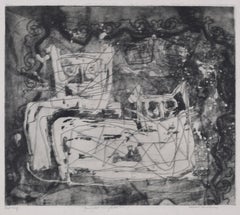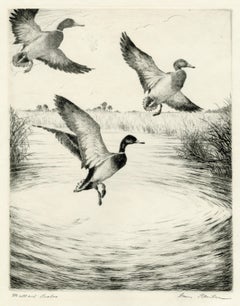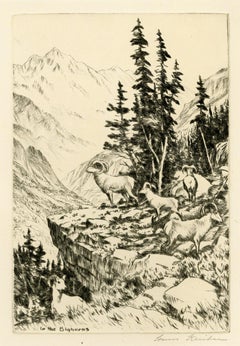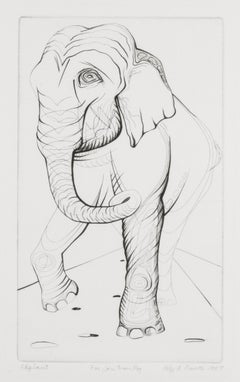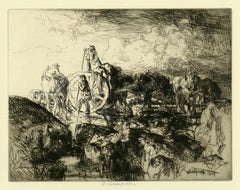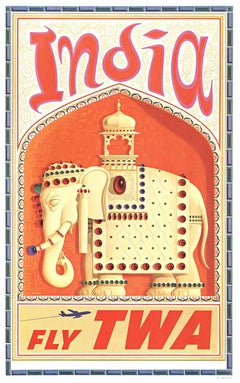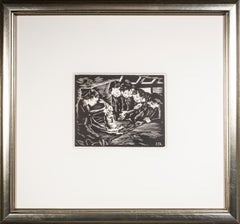Thomas French Fine Art Animal Prints
to
19
4
3
Overall Width
to
Overall Height
to
7
3
2
1
8
4
2
1
1
1
2
22
1
1
2
8
8
2
1
17
9
11
9
9
3
3
3
2
2
2
1
1
1
1
1
1
1
1
1
1
1
18
8
4
3
2
1
26
Animal Kingdom (Magnificent Jungle Cats)
By Louise Nevelson
Located in Fairlawn, OH
Animal Kingdom (Magnificent Jungle Cats)
Etching, 1953-1955
Signed and titled in pencil by the artist (see photos)
Annotated: "First Proof" (see photo)
Estate stamp verso (see photo)...
Category
1950s American Modern Prints and Multiples
Materials
Etching
Snow Geese (Wyoming)
Located in Fairlawn, OH
Snow Geese (Wyoming)
Drypoint, c. 1947
Signed in pencil lower right (see photo)
Title in pencil lower left (see photo)
Note: This image is reprodcued in a Photogravure for Ducks Unlimited in 1947. This is the first original drypoint version.
Condition: Excellent
Image/Plate size: 8 3/8 x 6 7/8 inches
Reference: Archives West #101
Kleiber 134
Hans Kleiber (1887-1967)
Hans Norbert Kleiber, painter, etcher, illustrator, and naturalist, was born in Cologne, Germany on August 24, 1887. He emigrated from Germany to the United States in 1900, settling in Massachusetts before moving to Wyoming. Kleiber first worked in lumber camps before working for the United States Forest Service from 1906 until 1924. One of his duties as a ranger was to monitor the logging camps in the Bighorn Mountains.
Kleiber was primarily self-taught as an artist and it was in the 1920s that he began devoting himself to art. It appears that he first began to work in watercolor and oil but was producing etchings and drypoints as early as 1924. He traversed the mountains of Wyoming, Montana, and Idaho, and his subjects are drawn from the pristine landscapes and wildlife.
Kleiber's first exhibition of his etchings was mounted in 1928 at Goodspeed's Book Shop in Boston. His etching, Crossing the Platte, was included in the 1939 New York World's Fair exhibition, American Art Today. There was an exhibition of fifty of his etchings at the National Museum in 1944, and an exhibition of his watercolors was mounted at the Grand Central Galleries in New York in 1950. Kleiber was a member of the Society of American Etchers and the California Society of Printmakers. He received a silver medal in 1931 from the Printmakers Society of California for his print, Leaving the High Country...
Category
1940s American Realist Animal Prints
Materials
Drypoint
Mallard Drakes (Louisiana Honkers)
Located in Fairlawn, OH
Mallard Drakes (Louisiana Honkers)
Drypoint, c. 1940
Signed in pencil lower right (see photo)
Titled in pencil lower left (see photo)
Note: A famous image by Kleiber. It is was made in a hand colored version which commands a large premium.
Condition: Excellent
Image/Plate size: 9 7/8 x 7 7/8 inches
Hans Kleiber (1887-1967)
Hans Norbert Kleiber, painter, etcher, illustrator, and naturalist, was born in Cologne, Germany on August 24, 1887. He emigrated from Germany to the United States in 1900, settling in Massachusetts before moving to Wyoming. Kleiber first worked in lumber camps before working for the United States Forest Service from 1906 until 1924. One of his duties as a ranger was to monitor the logging camps in the Bighorn Mountains.
Kleiber was primarily self-taught as an artist and it was in the 1920s that he began devoting himself to art. It appears that he first began to work in watercolor and oil but was producing etchings and drypoints as early as 1924. He traversed the mountains of Wyoming, Montana, and Idaho, and his subjects are drawn from the pristine landscapes and wildlife.
Kleiber's first exhibition of his etchings was mounted in 1928 at Goodspeed's Book Shop in Boston. His etching, Crossing the Platte, was included in the 1939 New York World's Fair exhibition, American Art Today. There was an exhibition of fifty of his etchings at the National Museum in 1944, and an exhibition of his watercolors was mounted at the Grand Central Galleries in New York in 1950. Kleiber was a member of the Society of American Etchers and the California Society of Printmakers. He received a silver medal in 1931 from the Printmakers Society of California for his print, Leaving the High Country...
Category
1940s American Realist Animal Prints
Materials
Drypoint
In th Bighorns (Wyoming)
Located in Fairlawn, OH
In th Bighorns (Wyoming)
Drypoint, c. 1930's
Signed in pencil lower right (see photo)
Titled in the plate lower left
Condition: Excellent
Image/Plate size: 6 3/8 x 4 3/8 inches
Hans Kleiber (1887-1967)
Hans Norbert Kleiber, painter, etcher, illustrator, and naturalist, was born in Cologne, Germany on August 24, 1887. He emigrated from Germany to the United States in 1900, settling in Massachusetts before moving to Wyoming. Kleiber first worked in lumber camps before working for the United States Forest Service from 1906 until 1924. One of his duties as a ranger was to monitor the logging camps in the Bighorn Mountains.
Kleiber was primarily self-taught as an artist and it was in the 1920s that he began devoting himself to art. It appears that he first began to work in watercolor and oil but was producing etchings and drypoints as early as 1924. He traversed the mountains of Wyoming, Montana, and Idaho, and his subjects are drawn from the pristine landscapes and wildlife.
Kleiber's first exhibition of his etchings was mounted in 1928 at Goodspeed's Book Shop in Boston. His etching, Crossing the Platte, was included in the 1939 New York World's Fair exhibition, American Art Today. There was an exhibition of fifty of his etchings at the National Museum in 1944, and an exhibition of his watercolors was mounted at the Grand Central Galleries in New York in 1950. Kleiber was a member of the Society of American Etchers and the California Society of Printmakers. He received a silver medal in 1931 from the Printmakers Society of California for his print, Leaving the High Country...
Category
1930s American Realist Animal Prints
Materials
Drypoint
Elephant
By Ray H. French
Located in Fairlawn, OH
Elephant
Engraing, 1957, printed 1988
Signed, dated, and titled in pencil by the artist
Dedicated: "For Jon From Ray"
Edition: 100 in two printings
This is an artist's proof from th...
Category
1950s American Modern Animal Prints
Materials
Engraving
A Jersey Vraic Cart
By Edmund Blampied
Located in Fairlawn, OH
A Jersey Vraic Cart
Etching, 1939
Signed lower center margin (see photo)
Signed and dated in the plate (see photo)
Edition 250 plus 10 on J. Whatman laid paper
Printed by David Stran...
Category
1930s English School Animal Prints
Materials
Etching
Canadian Geese in Flight
By Paul H. Winchell
Located in Fairlawn, OH
Canadian Geese in Flight
Drypoint printed with plate tone in the sky
c. 1940's
Signed in pencil lower right
Condition: Excellent
Image/Plate size: 8 3/8 x 10 1/4 inches
Provenanc...
Category
1940s American Realist Animal Prints
Materials
Drypoint
Eurito Echione e Etalide Argonote
Located in Fairlawn, OH
Eurito Echione e Etalide Argonote
Etching, 1664
after Remigio Cantagallina
From: La manifique carousel fait sur le fleuve de l"Arne a Florence, pour le Mariage du Grand Duc, (18 plates, this no. 14)
Depicts Three Argonauts conveyed on aquatic peacock
Published by Pierre Giffart, Paris
Note: This image is a record of the celebration on the Arno River in Florence of the marriage of Cosimo II de Medici and Maria Madaglena of Austria, 1608
Condition: Trimmed to the border line of the image
Slight foxing and staining to the sheet
Tipped on an "English Mount"
Image size: 3 9/16 x 4 15/16 inches
Reference: Bartsch XX.63.37 (copy after)
Drugulin 1179
Balthasar Moncornet
printmaker; publisher/printer
Tapissier, engraver and print publisher in Paris, specialist in ornament prints...
Category
1660s Old Masters Animal Prints
Materials
Etching
untitled (Duck taking to flight, flushed by a dog)
By Paul H. Winchell
Located in Fairlawn, OH
untitled (Duck taking to flight, flushed by a dog)
Drypoint & Aquatint, c. 1940
signed lower right
Created while the artist was a commercial artist working in Minneapolis, after his ...
Category
1940s American Realist Animal Prints
Materials
Drypoint
Dropping In
By Paul H. Winchell
Located in Fairlawn, OH
Dropping In
Drypoint, c. 1940
Signed lower right (see photo)
Titled lower left
Condition: Excellent
Brown paper tape around the sheet edges from
the printing and air dryi...
Category
1940s American Realist Animal Prints
Materials
Drypoint
White Head Eagle
By Katsunori Hamanishi
Located in Fairlawn, OH
White Head Eagle
Mezzotint printed in colors, 2014
Signed lower right (see photo)
Titled lower center (see photo)
WHITE HEAD EAGLE. The Print Club of Cleveland Publication No. 94, 20...
Category
2010s Contemporary Animal Prints
Materials
Mezzotint
Mr. C
By Kyohei Inukai
Located in Fairlawn, OH
Mr. C (Cat)
Linocut, 1984
Signed in pencil (see photo)
Edition: 250 (209/250) (see photo)
Published by Associated American Artists, New York, NY
Reference: AAA/Czestochowski 1984.009...
Category
1980s Contemporary Animal Prints
Materials
Linocut
Le Judgement de Paris ouf famille singe
By Paul Jouve
Located in Fairlawn, OH
Le Judgement de Paris ouf famille singe
Lithograph, 1897
Signed and dated in the stone lower right (see photo)
Published in L’Estampe Moderne with their blindstamp lower right corner, Lugt 2790 (see photo)
Edition 2000
Printed by Chapenois, Paris
Condition: Excellent
Image size: 9 5/8 x 13 5/8 inches
Sheet size: 12 x 15 3/4 inches
Paul Jouve (1878-1973)
Paul Jouve was two years old when his father set up his ceramist workshop on Boulevard Saint Jacques in Paris. It is in this artistic universe that he grew up playing with colors, modeling the earth, pampered by his young mother, who dreamed of making a teacher of her. Very early on, his father, seeing his passion for drawing, encouraged him, introduced him to the Jardin des Plantes, where he developed a passion for the big cats that he practiced drawing.
For the Universal Exhibition of 1900, the architect Binet, commissioned a frieze of wild animals of more than 100m representing tigers, bears, lions, bulls, and mouflons. This frieze will be executed in greenish brown glazed flamed sandstone by the sculptor Alexandre Bigot. Binet also ordered four lions from him to decorate the main gate of the Champs Elysees, between the two palaces, and a monumental statue representing a rooster wings outstretched in the center of the gate.
In 1907, Jouve was awarded a scholarship from the General Government of Algeria, and along with Léon Cauvy...
Category
1890s Art Nouveau Animal Prints
Materials
Lithograph
Strange Animals
By Ray H. French
Located in Fairlawn, OH
Strange Animals
Engraving, 1949
Signed, dated, and titled in pencil by the artist
The composition was created at the Univerisity of Iowa while the artist was enrolled in the famous M...
Category
1940s American Modern Animal Prints
Materials
Engraving
Strange Animals
By Ray H. French
Located in Fairlawn, OH
Strange Animals
Engraving, 1949
Signed, dated, and titled in pencil by the artist
The composition was created at the Univerisity of Iowa while the artist was enrolled in the famous M...
Category
1940s American Modern Animal Prints
Materials
Engraving
Untitled (Three Ducks Taking to Flight)
By Paul H. Winchell
Located in Fairlawn, OH
Untitled (Three Ducks Taking to Flight)
Drypoint, c. 1940
Signed lower right
Provenance: Estate of the Artist
Winchell Heirs by descent
Condition: Excellent
Image/Plate size: 10 1/2 x 8 1/4 inches
Sheet size: 12 1/2 x 10 5/16 inches
Created while the artist was a commercial artist working in Minneapolis, after his tenure of being an instructor at the Minneapolis Institute of Art in the 1930's.
Paul H. Winchell (1903 – 1971) was a printmaker, illustrator, teacher, and gilder according to Crump, 2009 (Minnesota Prints and Printmakers, 1900- 1945, Minnesota Historical Society Press). He was the son of Mrs. Looman Winchell of Shepherd Rd as noted in a 1937 newspaper article (Painsville, O. Telegraph). Winchell grew up in North Perry, Ohio and then studied and worked as an instructor at the Art Institute of Chicago. He studied with Leon Kroll (1884 – 1974), Boris Anisfeld...
Category
1940s American Realist Animal Prints
Materials
Drypoint
Lice
Located in Fairlawn, OH
Lice (Mallards grooming themselves)
Drypoint, 1927
Signed and dated lower right (see photo)
Titled lower left corner
Condition: Excellent
Image/Plate size: 6 7/8 x 10 3/4 inches
Shee...
Category
1920s American Realist Animal Prints
Materials
Drypoint
Magnificent Jungle Cats
By Louise Nevelson
Located in Fairlawn, OH
Magnificent Jungle Cats
Etching, drypoint and monoprint inking of the plate
Printed by the artist at Atelier 17, New York
Annotated 1/5 in pencil
Estate stamp and number, verso
Editi...
Category
1950s Abstract Abstract Prints
Materials
Etching
Aardvark
By Ray H. French
Located in Fairlawn, OH
Aardvark
Engraving, 1951
Signed, dated, titled in pencil by the artist (see photo)
Annotated "To Jon from Ray" (see photo)
Printed by Jon Clemens, Master Printer, c. 1990
Condition: ...
Category
1950s American Modern Animal Prints
Materials
Engraving
Walruses
By Ray H. French
Located in Fairlawn, OH
Walruses
Engraving, 1952
Signed, dated, titled and numbered (see photos)
Edition: 100, this from the second printing with the artist's initials in an edition of 25 (16/25)
Condition:...
Category
1950s American Modern Animal Prints
Materials
Engraving
Vienna Lipizzaner
By Ray H. French
Located in Fairlawn, OH
Vienna Lipizzaner
Engraving, 1962
Signed and dated lower right (see photo)
Titled and numbered lower left (see photo)
This impression is from the second edtition printed c. 1992
1st ...
Category
1960s American Modern Animal Prints
Materials
Engraving
La Pique (The Pike)
By Pablo Picasso
Located in Fairlawn, OH
La Pique (The Pike)
Lithograph, 1950
Original lithograph drawn with chalk and "frottage textures" transferred to stone, 1950.
Unsigned printer's proof
Inscribed on the verso in Mourl...
Category
1950s French School Animal Prints
Materials
Lithograph
Le Soir: Cerf et Herons (The Evening: Stag and Herons)
By Karl Bodmer
Located in Fairlawn, OH
Le Soir: Cerf et Herons (The Evening: Stag and Herons)
Lithograph printed with brown tint stone, 1858
From: Animaux et Paysages d’apres Nature
Published by Goupil, 1858
Signed in the stone lower left, Karl Bodmer Pinx. et lith. (see photo)
Published by Goupil et Cie, Paris, with their blindstamp center, below image
Printed by Bertauts, Paris (see photo)
Condition: Excellent
One stain verso, not visible on recto
Full sheet
Image size: 11 1/4 x 18 inches
Sheet size: 17 3/4 x 24 3/4 inches
Reference: Delteil 70
IFF 22, No. 1
Karl Bodmer
(1809—1893)
Painter, draftsman, and printmaker. Although he spent only two years in the United States and its territories, Bodmer's depictions of Western Indians...
Category
1850s Barbizon School Animal Prints
Materials
Lithograph
Snowy Egret
By Ray H. French
Located in Fairlawn, OH
Signed, dated, and titled in pencil by the artist
Dedicated: "To Jon From Ray"
Edition: 100 in two printings
A studio proof from the second printing by Jon Clemens, master printe...
Category
1950s Abstract Geometric Animal Prints
Materials
Engraving
Le Poissons magique
By Mario Avati
Located in Fairlawn, OH
Signed, titled and numbered in pencil
Edition: Epreuve d'Artiste viii/X
Reference: Passeron 359
"Mario Avati was both an etcher and a painter born in Monaco in 1921. In 1947, afte...
Category
1960s Abstract Geometric Animal Prints
Materials
Mezzotint
The Gull
By Ray H. French
Located in Fairlawn, OH
Signed, dated, titled in pencil by the artist; Annotated "To Jon from Ray"
Reproduced in the artists Retrospective Exhibition catalogue.
In the collection of the Wichita Art...
Category
1950s Prints and Multiples
Materials
Engraving
Related Items
Original Fly TWA India vintage travel poster David Klein
By David Klein
Located in Spokane, WA
Original Fly TWA India vintage travel poster. Artist: David Klein. Archival linen backed in very fine condition, ready to frame.
This poster features a...
Category
1960s American Modern Animal Prints
Materials
Offset
$999
H 40 in W 25 in D 0.05 in
'The Rabbit' original woodcut engraving by Clarice George Logan
By Clarice George Logan
Located in Milwaukee, WI
In 'The Rabbit,' Wisconsin artist Clarice George Logan presents the viewer with a multi-figural scene: under a wood-frame structure, four children crouch on the ground, gathered around a young woman who presents a rabbit. Under normal circumstances, such an image of children with a bunny would recall childhood storybooks. In this case, however, the image is more ambiguous and suggests the unfortunate economic circumstances many children suffered during the interwar years. Nonetheless, the group could also be interpreted as a nativity play, with the rabbit taking the place of the Christ child, shining light on the children like in a painting by the Italian Renaissance artist Correggio. The careful line-work of the woodblock engraving adds a sense of expressionism to the scene, leaving the figures looking distraught and dirty, though the image nonetheless falls into the Social Realist category that dominated American artists during the Great Depression.
This print was published in 1936 as part of the Wisconsin Artists' Calendar for the year 1937, which included 52 original, hand-made prints - one for each week of the year.
Clarice George Logan was born in Mayville, New York in 1909 but moved to Wisconsin in 1921. She attended the Milwaukee State Teachers College from 1927 to 1931 where she studied with Robert von...
Category
1930s American Modern Figurative Prints
Materials
Engraving, Woodcut
$1,300
H 12.37 in W 14.43 in
Seattle United Air Lines original vintage travel poster
Located in Spokane, WA
Original excellent condition, linen backed United Airlines: Seattle, the 1968 airplane airline aviation travel poster promoting travel to Seattle, Washington aboard United Airlines and featuring art of a Native American Indian totem pole...
Category
1960s American Modern Animal Prints
Materials
Offset
CANGREJO MANO LARGA
By Francisco Toledo
Located in New York, NY
paper: 22 x 15 in.
printed image: 4 3/4 x 6 in.
english translation: Long Hand Crab
Latin
Category
Late 20th Century Post-Modern Animal Prints
Materials
Archival Paper, Drypoint, Etching, Aquatint
Nebraska Evening
By Thomas Hart Benton
Located in London, GB
A fine impression with good margins published by Associated American Artists.
Category
1940s American Modern Landscape Prints
Materials
Lithograph
Haystack
By Thomas Hart Benton
Located in London, GB
A fine impression of this very popular image with full margins (smaller on top and bottom) published by Associated American Artists.
Category
1930s American Modern Landscape Prints
Materials
Lithograph
Alexander Calder Circus Reproduction Lithograph After a Drawing
By (after) Alexander Calder
Located in Surfside, FL
(after) Alexander Calder
"Calder's Circus" offset lithograph on wove paper after drawings by the artist
Published by Art in America and Perls gallery in 1964 (from drawings done in the 1930's)
these range slightly in size but they are all about 13 X 17 inches (with minor variations in size as issued.) These have never been framed. The outer folio is not included just the one lithograph.
James Sweeny from the introduction “The fame of Calder’s circus spread quickly between the years 1927 and 1930. All the Paris art world came to know it. It brought him his first great personal success. But what was more important, the circus also provided the first steps in Calder’s development as an original sculptor”
Clive Gray wrote ”A visit to the studio of Alexander Calder led to the chance discovery of some hundred masterful circus drawings completed over thirty years ago. We publish, for the first time, a choice of sixteen from that group.” With signed introduction by Miro.
These whimsical drawings, done in the style of wire sculpture, include acrobats, clowns, jugglers, trapeeze artists, an elephant, dog and lion. they are great.
Alexander Calder is widely considered to be one of the most important American sculptors of the 20th century. He is best known for his colorful, whimsical abstract public sculptures and his innovative mobiles, kinetic sculptures powered by motors or air currents, which embraced chance in their aesthetic. Born into a family of accomplished artists, Calder's work first gained attention in Paris in the 1930s and was soon championed by the Museum of Modern Art in New York, resulting in a retrospective exhibition in 1943. Major retrospectives were also held at the Solomon R. Guggenheim Museum (1964) and the Museum of Contemporary Art, Chicago (1974). Calder’s work is in many permanent collections, most notably in the Whitney Museum of American Art, but also the Guggenheim Museum; the Museum of Modern Art; the National Gallery of Art, Washington, D.C.; and the Centre Georges Pompidou. He produced many large public works, including .125 (at JFK Airport, 1957), Pittsburgh (Carnegie International prize winner 1958, Pittsburgh International Airport) Spirale (UNESCO in Paris, 1958), Flamingo and Universe (both in Chicago, 1974), and Mountains and Clouds (Hart Senate Office Building, Washington, D.C., 1976). Although primarily known for his sculpture, Calder was a prodigious artist with a restless creative spirit, whose diverse practice included painting and printmaking, miniatures (such as his famous Cirque Calder), children’s book illustrations, theater set design, jewelry design, tapestry and rug works, and political posters. Calder was honored by the US Postal Service with a set of five 32-cent stamps in 1998, and received the Presidential Medal of Freedom, posthumously in 1977, after refusing to receive it from Gerald Ford one year earlier in protest of the Vietnam War.
Calder moved to New York and enrolled at the Art Students League, studying briefly with Thomas Hart Benton, George Luks, Kenneth Hayes Miller, and John Sloan. While a student, he worked for the National Police Gazette where, in 1925, one of his assignments was sketching the Ringling Bros. and Barnum & Bailey Circus. Calder became fascinated with the action of the circus, a theme that would reappear in his later work.
In 1926, Calder moved to Paris, enrolled in the Académie de la Grande Chaumière, and established a studio at 22 rue Daguerre in the Montparnasse Quarter. In June 1929, while traveling by boat from Paris to New York, Calder met his future wife, Louisa James (1905-1996), grandniece of author Henry James and philosopher William James. They married in 1931. While in Paris, Calder met and became friends with a number of avant-garde artists, including Fernand Léger, Jean Arp, and Marcel Duchamp. Cirque Calder (on view at the Whitney Museum of American Art at present) became popular with the Parisian avant-garde. He also invented wire sculpture, or "drawing in space," and in 1929 he had his first solo show of these sculptures in Paris at Galerie Billiet. Hi! (Two Acrobats) in the collection of the Honolulu Museum of Art is an early example of the artist's wire sculpture. The painter Jules Pascin, a friend of Calder's from the cafes of Montparnasse, wrote the preface to the catalog. A visit to Piet Mondrian's studio in 1930, where he was impressed by the environment-as-installation, "shocked" him into fully embracing abstract art, toward which he had already been tending.
Dating from 1931, Calder’s sculptures of discrete movable parts powered by motors were christened “mobiles” by Marcel Duchamp, a French pun meaning both "motion" and "motive." At the same time, Calder was also experimenting with self-supporting, static, abstract sculptures, dubbed "stabiles" by Jean Arp in 1932 to differentiate them from mobiles.
Public commissions increasingly came his way in the 1960s. Notable examples are .125 for JFK Airport in 1957, Spirale for UNESCO in Paris 1958 and Trois disques, commissioned for Expo 67 in Montreal, Quebec, Canada. Calder's largest sculpture at 25.7 meters high was El Sol Rojo, constructed outside the Aztec Stadium for the 1968 Summer Olympics "Cultural Olympiad" events in Mexico City. Many of his public works were commissioned by renowned architects; I.M. Pei commissioned his La Grande Voile (1966), a 25-ton, 40-foot high stabile for the Massachusetts Institute of Technology.
Part of Calder's repertoire includes pivotal stage sets for more than a dozen theatrical productions, including Nucléa, Horizon, and most notably, Martha Graham’s Panorama (1935), a production of the Erik Satie symphonic drama Socrate (1936), and later, Works in Progress (1968).
In addition to sculptures, Calder painted throughout his career, beginning in the early 1920s. He picked up his study of printmaking in 1925, and continued to produce illustrations for books and journals.As Calder’s professional reputation expanded in the late 1940s and 1950s, so did his production of prints. Masses of lithographs based on his gouache paintings hit the market, and deluxe editions of plays, poems, and short stories illustrated with fine art prints by Calder became available for sale.
One of Calder's most celebrated and unconventional undertakings was a commission from Dallas-based Braniff International Airways to paint a full-size Douglas DC-8-62 four-engined jet as a "flying canvas."
Calder created over 2,000 pieces of jewelry over the course of his career, many of them as gifts for friends and relatives. For his lifelong friend Joan Miró, he set a shard of a broken porcelain vessel in a brass ring. Peggy Guggenheim received enormous silver mobile earrings and later commissioned a hammered silver headboard...
Category
1930s American Modern Animal Prints
Materials
Lithograph
Barnacle Geese Affrighted
Located in Middletown, NY
Etching and drypoint on cream wove paper, full margins. Signed and numbered 59/75 in pencil, lower margin. Notations in pencil along the lower sheet edge, recto, well outside of ima...
Category
Mid-20th Century Modern Animal Prints
Materials
Handmade Paper, Drypoint, Etching
Set of Three Engravings from "The British Sportsman" /// Osbaldiston Animal Art
Located in Saint Augustine, FL
Artist: William Augustus Osbaldiston (English, Active: Late 18th Century)
Titles: "Coursing" (Plate 3), "Hawking" (Plate 7), and "Hare Hunting" (Plate 8)
Portfolio: The British Sport...
Category
1790s English School Animal Prints
Materials
Laid Paper, Engraving, Intaglio
Jon Corbino, Montana Earthquake, 1936, lithograph
By Jon Corbino
Located in New York, NY
Works by Jon Corbino (1905-1964) feature drama. Here he's showing us the chaos produced by a major earthquake in rural Montana in 1936 -- an actual historical event.
The horses (ear...
Category
1930s American Modern Figurative Prints
Materials
Lithograph
Tigre couché à l'entrée de son antre (Tiger Lying at the Entrance to its Lair)
By Eugène Delacroix
Located in Middletown, NY
Etching, drypoint, and roulette on watermarked Hallines cream laid paper, 3 3/4 x 5 7/8 inches (95 x 148 mm), full margins. A very good impression of this charming image, with all of...
Category
Early 19th Century Realist Animal Prints
Materials
Laid Paper, Drypoint, Etching
Alexander Calder Circus Reproduction Lithograph After a Drawing
By (after) Alexander Calder
Located in Surfside, FL
(after) Alexander Calder
"Calder's Circus" offset lithograph on wove paper after drawings by the artist
Published by Art in America and Perls gallery in 1964 (from drawings done in the 1930's)
these range slightly in size but they are all about 13 X 17 inches (with minor variations in size as issued.) These have never been framed. The outer folio is not included just the one lithograph.
James Sweeny from the introduction “The fame of Calder’s circus spread quickly between the years 1927 and 1930. All the Paris art world came to know it. It brought him his first great personal success. But what was more important, the circus also provided the first steps in Calder’s development as an original sculptor”
Clive Gray wrote ”A visit to the studio of Alexander Calder led to the chance discovery of some hundred masterful circus drawings completed over thirty years ago. We publish, for the first time, a choice of sixteen from that group.” With signed introduction by Miro.
These whimsical drawings, done in the style of wire sculpture, include acrobats, clowns, jugglers, trapeeze artists, an elephant, dog and lion. they are great.
Alexander Calder is widely considered to be one of the most important American sculptors of the 20th century. He is best known for his colorful, whimsical abstract public sculptures and his innovative mobiles, kinetic sculptures powered by motors or air currents, which embraced chance in their aesthetic. Born into a family of accomplished artists, Calder's work first gained attention in Paris in the 1930s and was soon championed by the Museum of Modern Art in New York, resulting in a retrospective exhibition in 1943. Major retrospectives were also held at the Solomon R. Guggenheim Museum (1964) and the Museum of Contemporary Art, Chicago (1974). Calder’s work is in many permanent collections, most notably in the Whitney Museum of American Art, but also the Guggenheim Museum; the Museum of Modern Art; the National Gallery of Art, Washington, D.C.; and the Centre Georges Pompidou. He produced many large public works, including .125 (at JFK Airport, 1957), Pittsburgh (Carnegie International prize winner 1958, Pittsburgh International Airport) Spirale (UNESCO in Paris, 1958), Flamingo and Universe (both in Chicago, 1974), and Mountains and Clouds (Hart Senate Office Building, Washington, D.C., 1976). Although primarily known for his sculpture, Calder was a prodigious artist with a restless creative spirit, whose diverse practice included painting and printmaking, miniatures (such as his famous Cirque Calder), children’s book illustrations, theater set design, jewelry design, tapestry and rug works, and political posters. Calder was honored by the US Postal Service with a set of five 32-cent stamps in 1998, and received the Presidential Medal of Freedom, posthumously in 1977, after refusing to receive it from Gerald Ford one year earlier in protest of the Vietnam War.
Calder moved to New York and enrolled at the Art Students League, studying briefly with Thomas Hart Benton, George Luks, Kenneth Hayes Miller, and John Sloan. While a student, he worked for the National Police Gazette where, in 1925, one of his assignments was sketching the Ringling Bros. and Barnum & Bailey Circus. Calder became fascinated with the action of the circus, a theme that would reappear in his later work.
In 1926, Calder moved to Paris, enrolled in the Académie de la Grande Chaumière, and established a studio at 22 rue Daguerre in the Montparnasse Quarter. In June 1929, while traveling by boat from Paris to New York, Calder met his future wife, Louisa James (1905-1996), grandniece of author Henry James and philosopher William James. They married in 1931. While in Paris, Calder met and became friends with a number of avant-garde artists, including Fernand Léger, Jean Arp, and Marcel Duchamp. Cirque Calder (on view at the Whitney Museum of American Art at present) became popular with the Parisian avant-garde. He also invented wire sculpture, or "drawing in space," and in 1929 he had his first solo show of these sculptures in Paris at Galerie Billiet. Hi! (Two Acrobats) in the collection of the Honolulu Museum of Art is an early example of the artist's wire sculpture. The painter Jules Pascin, a friend of Calder's from the cafes of Montparnasse, wrote the preface to the catalog. A visit to Piet Mondrian's studio in 1930, where he was impressed by the environment-as-installation, "shocked" him into fully embracing abstract art, toward which he had already been tending.
Dating from 1931, Calder’s sculptures of discrete movable parts powered by motors were christened “mobiles” by Marcel Duchamp, a French pun meaning both "motion" and "motive." At the same time, Calder was also experimenting with self-supporting, static, abstract sculptures, dubbed "stabiles" by Jean Arp in 1932 to differentiate them from mobiles.
Public commissions increasingly came his way in the 1960s. Notable examples are .125 for JFK Airport in 1957, Spirale for UNESCO in Paris 1958 and Trois disques, commissioned for Expo 67 in Montreal, Quebec, Canada. Calder's largest sculpture at 25.7 meters high was El Sol Rojo, constructed outside the Aztec Stadium for the 1968 Summer Olympics "Cultural Olympiad" events in Mexico City. Many of his public works were commissioned by renowned architects; I.M. Pei commissioned his La Grande Voile (1966), a 25-ton, 40-foot high stabile for the Massachusetts Institute of Technology.
Part of Calder's repertoire includes pivotal stage sets for more than a dozen theatrical productions, including Nucléa, Horizon, and most notably, Martha Graham’s Panorama (1935), a production of the Erik Satie symphonic drama Socrate (1936), and later, Works in Progress (1968).
In addition to sculptures, Calder painted throughout his career, beginning in the early 1920s. He picked up his study of printmaking in 1925, and continued to produce illustrations for books and journals.As Calder’s professional reputation expanded in the late 1940s and 1950s, so did his production of prints. Masses of lithographs based on his gouache paintings hit the market, and deluxe editions of plays, poems, and short stories illustrated with fine art prints by Calder became available for sale.
One of Calder's most celebrated and unconventional undertakings was a commission from Dallas-based Braniff International Airways to paint a full-size Douglas DC-8-62 four-engined jet as a "flying canvas."
Calder created over 2,000 pieces of jewelry over the course of his career, many of them as gifts for friends and relatives. For his lifelong friend Joan Miró, he set a shard of a broken porcelain vessel in a brass ring. Peggy Guggenheim received enormous silver mobile earrings and later commissioned a hammered silver headboard...
Category
1930s American Modern Animal Prints
Materials
Lithograph
